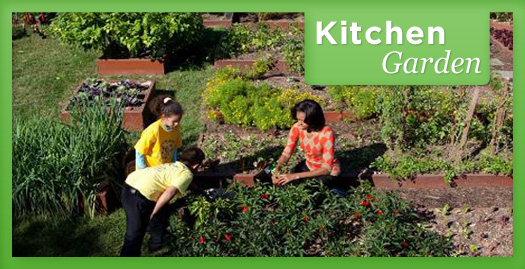
Kitchen Garden Checklist
A garden doesn't have to be a huge commitment, but with the right tools, a little time and easy-to-follow instructions you'll be on your way to developing your green thumb. Whether you choose to plant a modest window garden or a 4-acre plot, be sure to do it as a family -- the benefits of growing your own foods are endless.
Yummy harvest grilled pizza, a fresh chopped salad or even delicious fruit pie pockets are easy ways to use the vegetables and fruits you grow in your own garden for family meals.
Check out other recipes your family will love.
Before you start planting, read and download this step-by-step guide, which offers important information about how to safely grow your own fruits and vegetables with your family:
Involve Your Family
Since the First Lady first broke ground on the South Lawn, people across the country have revisited the American tradition of starting a vegetable garden at home. First step is talking to your family members about starting a vegetable garden for your home. From selecting plants and seeds to harvesting vegetables, gardening is a fun way to spend time together and enjoy delicious meals around the dinner table. If you’re looking for inspiration, follow the First Lady’s lead and see what was harvested from the White House Kitchen Garden.
Choose a Site
Whether your home has a backyard or a kitchen window, you can have your own garden. A good gardening space receives at least six hours of sunlight per day and has a conveniently located water source. If you don’t have a large outdoor space, consider container gardening on your porch or balcony.
Garden Healthy
Before growing food in your backyard, take samples of the soil and have them analyzed to find out soil type and quality. Consult with your nearest Cooperative Extension office to determine how to take a soil sample and where to send it. The quality of your soil will affect the health of your crops and the design of your garden. Mulch the soil around your plants to improve your soil quality, lock in moisture and keep out weeds. In the winter, you can grow a cover crop or add nutrients to your soil.
Design Your Garden
Did you know that The White House Kitchen Garden is 1,500 square feet? Good news: you don’t need that much space to grow your own food. A garden takes tending, so start small at first. Spend a fun evening with your family members sketching out a simple design for your garden to determine how much space you have for each plant. Discuss growing food in raised beds, containers, or in the ground. Put the tallest plants in the back of the garden to prevent the small plants from getting too much shade, and set your garden rows north to south to maximize the sun’s rise and fall. You might consider installing a rain barrel, fence, compost bin, or a pathway in your garden, too.
Get Growing
You can plant the seeds of crops like peas and beans directly into your garden soil, while other crops like tomatoes need to be started indoors and later transplanted outside. You can call your local Cooperative Extension office for information specific to your local growing region, including planting dates for warm and cool season crops and the last day of frost. Some easy, hardy vegetables for growing include: peas, beans, lettuce, melons, cucumbers, broccoli, collards, peanuts, peppers, onions, tomatoes, radishes. What's growing in the White House Kitchen Garden right now? Potatoes, spinach, lettuce, radishes, chard, rapini, carrots, bok choy, broccoli, onions and mustard greens.
If you’re undecided about which vegetable varieties to grow, visit Vegetable Varieties for Gardeners. As you plant, mark your rows with sturdy labels so you remember what you planted. Invite your neighbors and friends over to help you plant; teach your family members to water the garden and pull weeds to keep your plants healthy.
Watch how the White House extended its growing season:
Don’t give up! If you are having trouble with your garden, don’t get frustrated. Gardening involves trial and error, and you learn as you go. Your garden will get better over time, year after year. If you have questions about insects, disease, or plant nutrients, you can contact your local Cooperative Extension Agent. Your Cooperative Extension Service may also have an Extension Master Gardener volunteer in your area to help with gardening challenges, or you may be able to take part in trainings to learn more about how to garden.
Enjoy Your Harvest
When your vegetables are ready for harvest, plan a family dinner together! Check out some of The White House Kitchen Garden recipes that use food from the garden. Consider sharing your extra harvest with neighborhood food pantries, kitchens, and shelters.
Information provided courtesy of USDA’s People’s Garden Initiative. For more gardening resources visit www.usda.gov/peoplesgarden.

